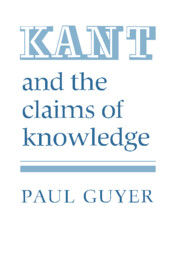Book contents
- Frontmatter
- Contents
- Acknowledgments
- Note on sources
- Introduction
- Part I Kant's early view
- Part II The transcendental deduction from 1781 to 1787
- Part III The principles of empirical knowledge
- 6 The schematism and system of principles
- 7 Axioms and anticipations
- 8 The general principle of the analogies
- 9 The first analogy: substance
- 10 The second analogy: causation
- 11 The third analogy: interaction
- Part IV The refutation of idealism
- Part V Transcendental idealism
- Afterword
- Notes
- Index of passages cited
- General index
9 - The first analogy: substance
Published online by Cambridge University Press: 09 March 2010
- Frontmatter
- Contents
- Acknowledgments
- Note on sources
- Introduction
- Part I Kant's early view
- Part II The transcendental deduction from 1781 to 1787
- Part III The principles of empirical knowledge
- 6 The schematism and system of principles
- 7 Axioms and anticipations
- 8 The general principle of the analogies
- 9 The first analogy: substance
- 10 The second analogy: causation
- 11 The third analogy: interaction
- Part IV The refutation of idealism
- Part V Transcendental idealism
- Afterword
- Notes
- Index of passages cited
- General index
Summary
Kant had intended to construct three analogies of experience since his first conception of a transcendental theory of experience. Perhaps this explains why we shall find a higher degree of clarity and uniformity in the arguments for the universal applicability of laws of causation and interaction in the second and third analogies than we find in the case of arguments which Kant had hardly invented before publishing – that is to say, of course, the transcendental deduction and, as we shall see, the refutation of idealism. But we also saw that Kant's original theory appealed to three “analogies of appearance” without delivering arguments for or from them, and we shall now see that in the case of the first analogy Kant's long search for an argument for the necessity of permanent substance as a condition of time-determination did not result in the formulation of a single argument with a clearly defined structure. Instead, the text, as Kant published it in the first edition of the Critique and emended it in the second, conflates at least three different arguments. After a comment on Kant's two versions of the “Principle of the Permanence of Substance” itself (A 180 / B 224), I will analyze these three styles of argument.
In the first edition of the Critique, Kant states the principle as “All appearances contain the permanent {substance) as the object itself, and the changeable as its mere determination, that is, a way in which the object exists” (A 182). In the second edition, Kant substitutes this: “In all change of appearances, substance endures, and its quantum in nature is neither increased nor diminished” (B 224).
- Type
- Chapter
- Information
- Kant and the Claims of Knowledge , pp. 215 - 236Publisher: Cambridge University PressPrint publication year: 1987



